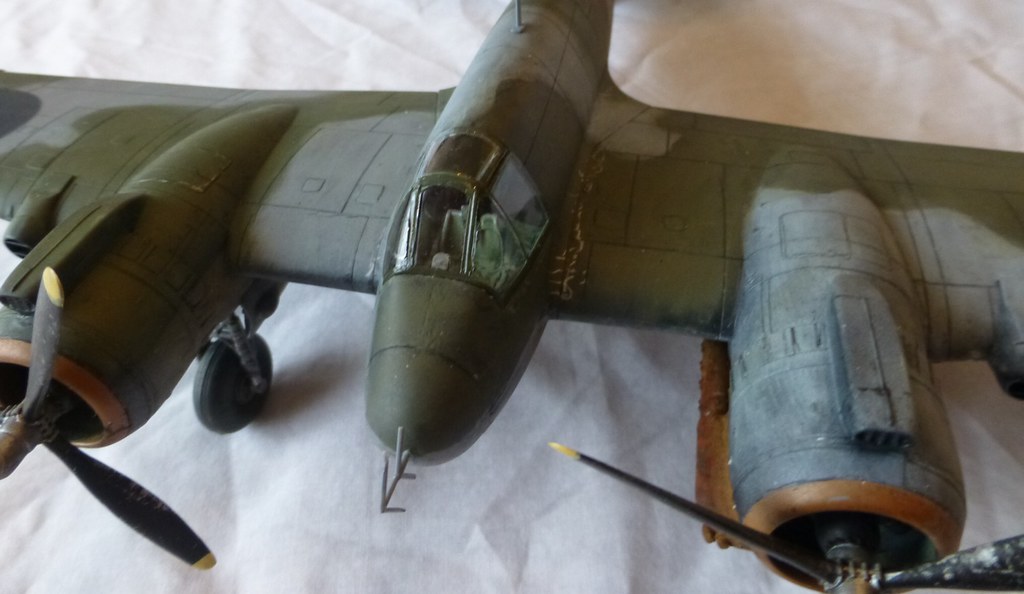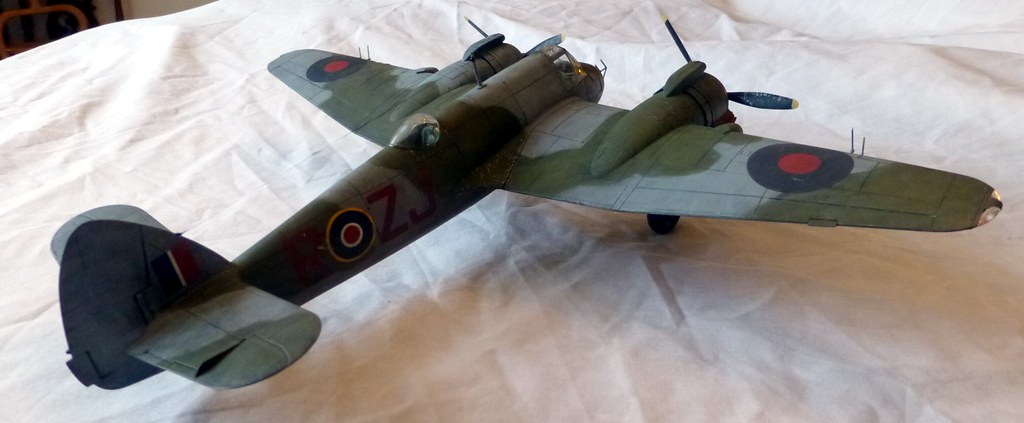Okay, Beaufighter is a wrap. I'm within a couple of days of loading up our car and driving from St. Paul to Berkeley, so I didn't have time to do some things that I would have liked. I should have made a simple base for it. I also should have had some Tamiya colored clear for the lights. Next time.
The whole point of this kit was to try to get the look of a well worn plane in WWII service. That wasn't all of them of course (new planes came in regularly) but it didn't take much service for a plane to show wear and tear – all flew in what today's passenger would consider beastly conditions, and the maintenance given was usually well inspired but often under supplied. The percentage of frontline aircraft that in peace would have been either junked or sent home for complete overhaul was probably over half in any veteran squadron.
Beaufighter units did stick around. The plane was used from the beginning of the war to the end. (Beaufighters may have flown the last operational mission against wayward U-boats reluctant to surrender two weeks after German surrender.) It was in every theater. (It was the first modern combat plane built in Oz, and about 600 were made there.) It was a plane that accepted adaptation well. The Beaufighter was a variation on a very mediocre bomber the Bristol Beaufort. It's mutant background led to an odd look to the plane with it's short and stubby nose. The Beaufort was powered by the excellent Hercules radial – and when a larger version was available, the Mk. VI Beaufort appeared, easily recognizable by its pronounced dihedral on the tail. The plane I built flew for 96th Squadron out of Scotland and participated in night fighter operations in the North Sea. The Beaufighter never received the rave reviews of the Mosquito, but it was more rugged and proved well worth the schillings spent. 6,000 were built and served in active RAF and RAAF service until 1960. (Some served with the IDF in its early years.) Below are pics of an early mark (in Oz I think) and a Mk VI flying from the Western Desert. (Anyone interested in seeing a bang-up WWII aviation documentary should check out “Whispering Death”, a 70 minute show done on a low budget highlighting the Beaufighter in Australian service. Terrific combat film interwoven with interviews with Australian participants running from Air Group Commander William Garing – the longest lived of the RAAF's WWII bigwigs – to some ground crew. A few years back I wrote a book about the air war in the South/Southwest Pacific titled Fire in the Sky. Garing and a pilot named Bill Cassidy were terrific interviews.)
 photo3 by Eric Bergerud, on Flickr
photo3 by Eric Bergerud, on Flickr
 Photo4 by Eric Bergerud, on Flickr
Photo4 by Eric Bergerud, on Flickr
 photo6 by Eric Bergerud, on Flickr
photo6 by Eric Bergerud, on Flickr
The major changes made to the kit since the last view included final assembly (especially clear parts); oil dot fading which I liked a lot and a good dose of pigments on the bottom. The exhaust is amplified which is definitely justified if you look at enough films and photos. WWII radials leaked oil, and two whopping big ones would leak a lot – because the exhausts run under the wings a very large exhaust stream from across the lower wing. As I understand it, the stains were more of a greenish brown than black. And as these planes normally operated out of pretty crude strips in today's standards, I gave the bottom a good dose of several colors of pigments. I enhanced the panel lines with Verithin pencils which work nicely – I wish I had done it in a shade of gray instead of black. Overall I'm pretty happy. I liked the black basing. The Golden High Flow Paints were a delight for airbrush use. I think the weathering was about right. Pics below:
 piclftab by Eric Bergerud, on Flickr
piclftab by Eric Bergerud, on Flickr
 Picftrt by Eric Bergerud, on Flickr
Picftrt by Eric Bergerud, on Flickr
 Picftlt by Eric Bergerud, on Flickr
Picftlt by Eric Bergerud, on Flickr
 PicFtDet by Eric Bergerud, on Flickr
PicFtDet by Eric Bergerud, on Flickr
 PicBot1 by Eric Bergerud, on Flickr
PicBot1 by Eric Bergerud, on Flickr
 picab! by Eric Bergerud, on Flickr
picab! by Eric Bergerud, on Flickr
 PicRt1 by Eric Bergerud, on Flickr
PicRt1 by Eric Bergerud, on Flickr
 picrtabr! by Eric Bergerud, on Flickr
picrtabr! by Eric Bergerud, on Flickr
 pictpdet by Eric Bergerud, on Flickr
pictpdet by Eric Bergerud, on Flickr